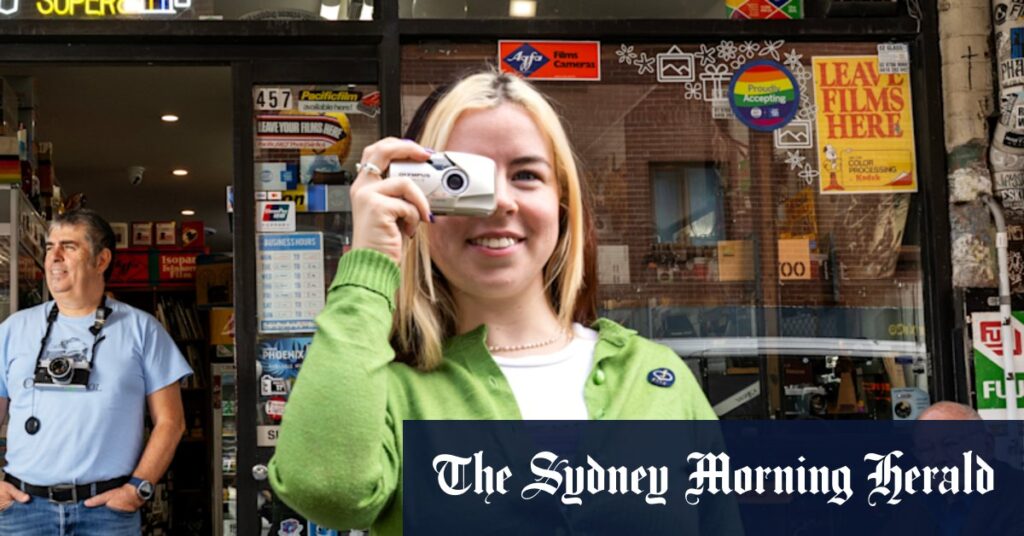
If Sydney Super8 had a shopkeeper’s doorbell on a Friday afternoon, it would be ringing constantly with the steady stream of young people coming and going. The old-school film and camera shop, nestled in the vibrant suburb of Newtown, Sydney, is experiencing a renaissance, largely fueled by the enthusiasm of millennials and Generation Z.
With its bright Kodak-yellow exterior, Sydney Super8 has become an iconic institution, attracting a new generation of film enthusiasts. The narrow shop space is often bustling with young customers dropping off single-use cameras for processing, purchasing rolls of film, or seeking advice from current owner Nick Vlahadamis and former owner Christopher Tiffany. “Our customers are 90 percent young people and maybe 75 percent of the time they are female,” Tiffany notes.
The Role of Social Media and Nostalgia
The resurgence of interest in film photography is closely tied to the influence of social media. “Social media has an impact, it’s really weird, [that] digital social media has an impact on an old technology. I think the same thing happened with records,” Vlahadamis explains. This paradoxical trend sees digital platforms driving a renewed appreciation for analog experiences.
Lilly Orrell, a 26-year-old customer, embodies this shift. She uses her film camera to capture candid moments with friends and on vacations, appreciating the authenticity that film offers. “It captures the moment, you can’t be like ‘I look ugly’ and re-take it… The photo is what it is,” Orrell shares, highlighting the contrast with curated digital images on social media.
Industry Dynamics and Challenges
The revival of film photography comes at a time when industry giants like Eastman Kodak face significant challenges. In August, Kodak reported its quarterly filings, revealing substantial debt, prompting concerns about its future. However, Kodak reassured the public, stating,
“Kodak has no plans to cease operations” and is “confident it will repay, extend, or refinance its debt.”
Meanwhile, the film industry is witnessing a cautious optimism with new product launches. Japanese camera manufacturer Pentax introduced the Pentax 17, the first new film camera from a major brand in over two decades. “It’s a camera that shouldn’t exist today. They have almost sold out globally,” Vlahadamis remarks, emphasizing the unexpected demand.
Similarly, FujiFilm Australia re-launched the QuickSnap, a 35mm single-use camera targeting Gen Z customers. Mary Georgievski, FujiFilm Australia’s general manager, explains,
“Gen Z are a lot about mental health, slowing things down, realizing what we had in the past was great.”
The Allure of Analog
For many young people, film photography offers a mindful alternative to the instant gratification of digital cameras. Denis Hasagic, a regular at Sydney Super8, initially planned to buy a digital camera but was captivated by the charm of film. “I saved up all this money for a digital camera and then got a film camera for much cheaper,” Hasagic recalls.
Professional photographer Julia Sarantis echoes this sentiment, describing the magic of film development. “Even though it’s heartbreaking, there are so many rolls [of film] that just didn’t turn out … but it’s magic when it happens,” she says. Sarantis discovered her passion for film photography during a university elective, drawn to the tactile nature of the medium.
Looking Forward
As Sydney Super8 continues to thrive, Vlahadamis hopes for a greater appreciation of physical prints among younger customers. “You get one shot. We are in such an era right now where everything is instant … You’re going back to the future in a way,” he reflects.
The revival of film photography is more than a nostalgic trend; it represents a cultural shift towards valuing the tangible and imperfect. As Gen Z navigates a digitally saturated world, their embrace of analog technology offers a refreshing reminder of the beauty in simplicity and authenticity.






